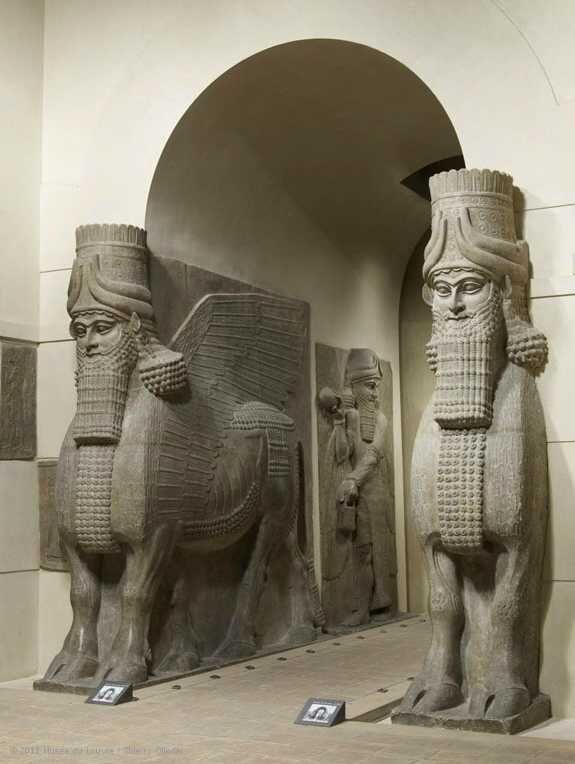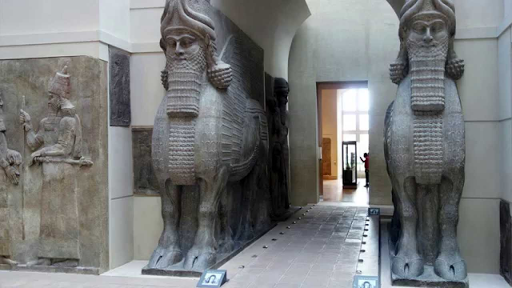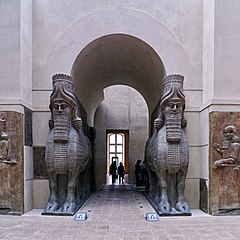Human-headed Winged Lion is a raised relief sculpture of a Lamassu with the body of a lion made of gypsum alabaster. They were excavated beginning in 1853 by the archaeologist Hormuzd Rassam and are now in the British Museum.
Where were the Lamassu sculptures originally displayed.

. The Assyrians envisioned a protective spirit that was part bull and part human and sometimes part eagle. What color is lapis lazuli. 720-705 BCE gypseous alabaster 420 x 436 x 097 m excavated by P-E.
Chicagos bull seems to have been on display undisturbed since 1931. And the lamassu which were thought of as protective deities stood guard either side of an entrance way. An American professor named Michael Rakowitz was commissioned to recreate this Lamassu sculpture and it is now displayed in Trafalgar Square in London.
Then in April 1991 Michael Bourbon master conservator from Paris arrived in Chicago to create a silicone and plaster cast of the lamassu. What ethnic group is credited with the first system of writing known to man. Looking up the lamassu that have been displayed in the.
Which work has a king approaching the god Shamash. The great Assyrian king Ashurnasirpal II r. In the Assyrian mythology there were human headed winged bullslions that were protective genies.
They were represented as double-aspect figures on corners in high relief. A replica of Chicagos bull was made and displayed at. A Sargons palace b Gudeas Lagash c Ashurbanipals palace d Ziggurat at Ur Which of the following played an important role in the shaping of modern art.
They were found in the North Palace at Ninevah right across the river from present day Mosul in Iraq. On view at The Met Fifth Avenue in Gallery 401. It is 164cm tall and 343cm long which is larger than an actual average lion.
The Assyrians came first. Human-headed winged lion lamassu ca. Also to know where were these relief sculptures displayed in the ancient Assyrian palace.
Which work has a king approaching the god. The first change was the capital was moved to Dur Sharrukin present day Khorsabad and second the Lamassu was presented on a bulls body compared to a lions and seems to be slightly smiling. Beth Harris and Dr.
The Lamassu sculptures were recovered from where. You can see them at Gate of All Nations at Persepolis in Iran the British Museum in London the Louvre in Paris the National Museum of Iraq in Baghdad the Metropolitan Museum of Art in New York and the University of Chicago Oriental Institute. The Ziggurat at Ur was a fortress funerary monument palace temple platform Where were the Lamassu sculptures originally displayed.
From the ninth to the seventh century BC the kings of Assyria ruled over a vast empire centered in northern Iraq. It was originally made for Hatshepsuts funerary temple at Deir el-Bahri which is a complex of temples dedicated to pharaohs of her family. Recent reports indicate that the.
The Lamassu sculptures were recovered from where. Lamassu winged human-headed bulls possibly lamassu or shedu from the citadel of Sargon II Dur Sharrukin now Khorsabad Iraq Neo-Assyrian c. In some cases the lamassu statues were accompanied by.
Much the best-known works are the huge lamassu guarding. From what we can tell it seems that these sculptures were believed to protect the palace and king from evil supernatural forces as well. What ethnic group is credited with the first system of writing known to man.
They have been thought to be very strong animals and functioned both as a clear reminder of the kings supreme authority and symbols of security for all people. Assyrian sculpture typically placed prominent pairs of lamassu at entrances in palaces facing the street and also internal courtyards. It comes from Mesopotamia and is believed to.
Other lamassu survive on display in New York Paris London Chicago and Baghdad but now only Nimrud and Susa retain lamassu at their original locations. Steven Zucker IN THE NEWS. Click to see full answer.
Assyrian sculpture is the sculpture of the ancient Assyrian states especially the Neo-Assyrian Empire of 911 to 612 BC which ruled modern Iraq Syria and parts of IranIt forms a phase of the art of Mesopotamia differing in particular because of its much greater use of stone and gypsum alabaster for large sculpture. The most famous colossal statues of Lamassu have been excavated at the sites of the Assyrian capitals established by King Assurnasirpal II reigned 883 859 BCE and King Sargon II reigned 721 705 BCE. 883859 BC undertook a vast building program at Nimrud ancient Kalhu.
What were the most common themes in Assyrian art. Botta 1843-44 Musée du Louvre Speakers. Furthermore where were the lamassu sculptures originally displayed.
Lamassu are human-headed eagle-winged bulls or lions who once shielded cities in Mesopotamia. Irreplaceable Lamassu sculpture Assyrian architecture and. This replica was made with 10000 Iraqi date syrup cans and serves as a symbol of.
The most famous colossal statues of Lamassu have been excavated at the sites of the Assyrian capitals created.
Human Headed Winged Bull Lamassu Assyrian Neo Assyrian The Metropolitan Museum Of Art

Lamassu Backstory Article Assyrian Khan Academy
Human Headed Winged Lion Lamassu Assyrian Neo Assyrian The Metropolitan Museum Of Art

Lamassu From The Citadel Of Sargon Ii Video Khan Academy

Lamassus At The Louvre Thatmuse

Lamassu History 2701 Wiki Fandom

25 Lamassu From The Citadel Of Sargon Ii Dur Sharrukin Modern Iraq Ap Art History


0 comments
Post a Comment